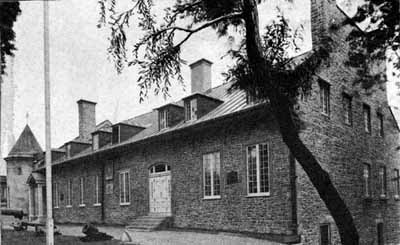Château De Ramezay / India House National Historic Site of Canada
Montréal, Quebec

General view
© Agence Parcs Canada / Parks Canada Agency, A. J. H. Richarson, 1968.
Address :
280 Notre-Dame Street East, Montréal, Quebec
Recognition Statute:
Historic Sites and Monuments Act (R.S.C., 1985, c. H-4)
Designation Date:
1949-05-30
Dates:
-
1705 to 1705
(Construction)
-
1756 to 1756
(Significant)
-
1775 to 1776
(Significant)
-
1773 to 1844
(Significant)
-
1756 to 1767
(Significant)
Event, Person, Organization:
-
General Sir Guy Carleton(Lord Dorchester)
(Person)
-
Sir Frederick Haldimand
(Person)
-
Sir George Prevost
(Person)
-
Brigadier-General David Wooster
(Person)
-
Hazen
(Person)
-
Benedict Arnold
(Person)
-
Brigadier-General Sir Isaac Brock
(Person)
-
Claude de Ramezay
(Person)
-
Compagnie des Indes occidentales
(Organization)
-
Pierre Couturier
(Architect)
-
Claude Tessier-Lavigne
(Builder)
Other Name(s):
-
Château De Ramezay / India House
(Designation Name)
-
India House
(Other Name)
-
Château de Montréal
(Other Name)
-
Château Ramezay
(Other Name)
Research Report Number:
2006-CED-SDC-034
Plaque(s)
Existing plaque: 280 Notre-Dame Street East, Montréal, Quebec
The Château was built in 1705 by Pierre Couturier, as a residence for Claude de Ramezay, Governor of Montreal. The Compagnie des Indes occidentales, which owned it from 1745-1763, had it rebuilt and enlarged in 1756 after plans by Paul Tessier dit Lavigne. It was the Montreal residence of the Governors General, 1773-1844, and was occupied by American invaders in 1775-76. In 1839 the Château housed the Executive Council and after 1849 other government offices, courts of law and schools. In 1895 it became the headquarters and museum of the Antiquirian and Numismatic Society of Montreal.
Description of Historic Place
Château De Ramezay / India House National Historic Site of Canada is a private mansion situated on Notre-Dame Street east, in the Old Port of Montréal, Quebec. First constructed in 1705, the stone building was rebuilt after a fire in 1756. Surrounded by a small wall, the Château De Ramezay / India House is a one-and-a-half storey stone building to which was added an eastern extension with a conically- roofed tower in 1903. The site also contains the Governor’s garden, which was constructed at the rear of the building in 2000. Official recognition refers to the property of Chateau De Ramezay.
Heritage Value
Château De Ramezay / India House was designated as a national historical site of Canada in 1949, because: it was built in 1705 by the Governor of Montréal, Claude de Ramezay; it contributed importantly to the political and commercial life of New France and of Lower Canada for more than two centuries; it was owned by the Compagnie des Indes occidentales from 1745 to 1763; it served as the official residence of the Governors-in-Chief of British North America from 1773 to 1844, except for the period between 1775 and 1776 when the site was occupied by American invaders.
The heritage value of the site resides in its political and mercantile affiliations. Château De Ramezay / India House was first built for Claude de Ramezay, who was the governor of Montreal from 1704 to 1724, and the acting Governor General of New France for three years (1714-1716). The construction of the building reflects the status and financial situation of Montreal’s governors who built their own private mansions that French crown did not provide them.
From 1745 –1763, the building was used by the Compagnie des Indes occidentales as a base of operations, during which time it was rebuilt and enlarged after a fire in 1756. The trading company played an important role in Canada’s economic life, benefiting from a monopoly on exported beaver pelts and on the imports of some textiles needed as exchange merchandise.
From 1773-1844, during the Lower Canada period, the Château de Ramezay became the official residence of the Governors-in-Chief of British North America, excluding the period of American occupation from 1775 to 1776, when it became the residence of successive American commanders. The importance of the site is thus exhibited in the continuity of its usage. In 1839, it housed the Executive Council and after 1849, the building was used for other government offices, courts of law and schools. In 1895, the mansion was converted into the headquarters and museum of the Antiquarian and Numismatic Society of Montréal.
Sources: Historic Sites and Monuments Board of Canada, Minutes, 1949; 1970; 2007.
Character-Defining Elements
Key elements that contribute to the heritage value of this site include: its location on Notre-Dame street East, in the Old Port of Montréal, Quebec; any remaining exterior or interior architectural elements and features dating from the 1756-1844 period, including its formwork, materials and handicrafts; vestiges still present in the exterior architecture relating to the importance of the mansion, including impressive gable parapets, the freestone used in the ornaments, the quarry stones used in the walls, and the high stone chimneys; interior elements relating to the various periods of occupation, such as the vaulted basements; its link with the spaces and public institutions situated around the building.